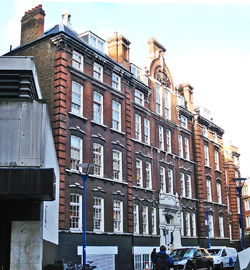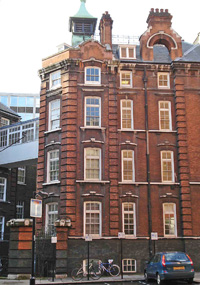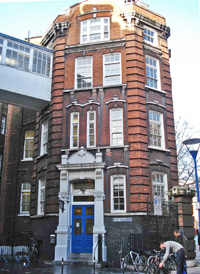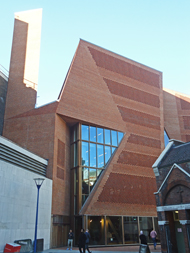St Philip's Hospital
Sheffield Street, WC2A 2EX
Medical dates:
Medical character:
Specialist
Originally built in 1903 as a
workhouse
infirmary by the Strand Union, the St Philip's Building was used
during WW1 as an observation hospital for war refugees.
In 1919 the Ministry of Health was approached by the Home Secretary concerning immediate provision of accommodation for the reception and treatment of young girls and women with venereal disease (VD) who had come into the hands of the Women Police patrols (cases of this class had previously been dealt with at the infirmary of the Chelsea Guardians, who wished to be relieved of the work).
In 1919 the Metropolitan Asylum Board purchased the Strand Union workhouse in Sheffield Street for £20,000. In 1920 it was adapted for use as a hospital for women suffering from VD. The larger (south) block, Sheffield House, contained the administrative offices and staff accommodation. The treatment rooms and wards were in the north block, together with the kitchen and the patients' dining room.
Although the hospital had been intended "not for the prostitute class or for persons convicted in police courts for soliciting or other offences, but for girls who had followed soldiers from the country or who been infected as a result of an occasional lapse into immorality", a large number of patients came under these former categories, "many of a very depraved class who refused to stay more than 2-3 weeks. They used the most offensive language and had the coarsest of manners". Patients of the class originally expected were frequently directed elsewhere.
In 1930 the Hospital came under the control of the LCC and was renamed Sheffield Street Hospital. Extra wards were added in Sheffield House. The Hospital could then accommodate 52 patients.
It joined the NHS in 1948, coming under the administration of the Paddington Hospital Management Committee.
The introduction of penicillin had greatly lessened the need for specialist VD hospitals and in 1952 it was renamed St Philip's Hospital and joined the St Peter's and St Paul's group - the third member of the '3 Ps' - hospitals which specialized in diseases of the kidneys and urinary system. St Philip's dealt with chronic urological cases and at this time had 57 beds.
By 1969 it had 26 beds. It closed in 1992, at the same time as St Peter's and St Paul's, and nephrology services moved to the Middlesex Hospital.
In 1919 the Ministry of Health was approached by the Home Secretary concerning immediate provision of accommodation for the reception and treatment of young girls and women with venereal disease (VD) who had come into the hands of the Women Police patrols (cases of this class had previously been dealt with at the infirmary of the Chelsea Guardians, who wished to be relieved of the work).
In 1919 the Metropolitan Asylum Board purchased the Strand Union workhouse in Sheffield Street for £20,000. In 1920 it was adapted for use as a hospital for women suffering from VD. The larger (south) block, Sheffield House, contained the administrative offices and staff accommodation. The treatment rooms and wards were in the north block, together with the kitchen and the patients' dining room.
Although the hospital had been intended "not for the prostitute class or for persons convicted in police courts for soliciting or other offences, but for girls who had followed soldiers from the country or who been infected as a result of an occasional lapse into immorality", a large number of patients came under these former categories, "many of a very depraved class who refused to stay more than 2-3 weeks. They used the most offensive language and had the coarsest of manners". Patients of the class originally expected were frequently directed elsewhere.
In 1930 the Hospital came under the control of the LCC and was renamed Sheffield Street Hospital. Extra wards were added in Sheffield House. The Hospital could then accommodate 52 patients.
It joined the NHS in 1948, coming under the administration of the Paddington Hospital Management Committee.
The introduction of penicillin had greatly lessened the need for specialist VD hospitals and in 1952 it was renamed St Philip's Hospital and joined the St Peter's and St Paul's group - the third member of the '3 Ps' - hospitals which specialized in diseases of the kidneys and urinary system. St Philip's dealt with chronic urological cases and at this time had 57 beds.
By 1969 it had 26 beds. It closed in 1992, at the same time as St Peter's and St Paul's, and nephrology services moved to the Middlesex Hospital.
Present status (January 2008)
The building is now occupied by the London School of Economics. St Philip's Medical Centre is located in the main block.
Update: October 2014
In 2010 the London School of Economics announced plans to demolish the building and to build a £21.5 seven-storey Student Centre.
Completed in December 2013 at a cost of £24.1m, the Saw Swee Hock Student Centre was officially opened on 24th October 2014.
The building is now occupied by the London School of Economics. St Philip's Medical Centre is located in the main block.
Update: October 2014
In 2010 the London School of Economics announced plans to demolish the building and to build a £21.5 seven-storey Student Centre.
Completed in December 2013 at a cost of £24.1m, the Saw Swee Hock Student Centre was officially opened on 24th October 2014.

The former Hospital building in Sheffield Street.

The main entrance.

The Sheffield Street elevation of the north block.

The north block of the Hospital was joined by a bridge to the main building; the bridge can just be seen in the top left of the photo.

Sheffield House can be seen on the left and the north annexe on the right.
Update: October 2014

The Saw Swee Hock Student Centre.

The main entrance.
Black N 2006 Walking London's Medical History. London, Royal Society of Medicine Press
http://londonist.com
http://stphilipsexhibition.files.wordpress.com
www.architecture.com
www.baus.org.uk
www.lse.ac.uk
www.lsesu.com
www.victoriansociety.org.uk
www.workhouses.org.uk
Return to home page